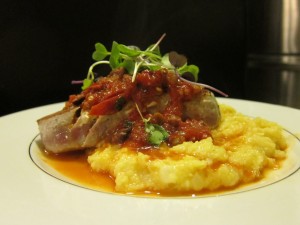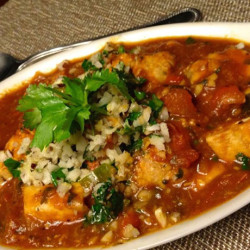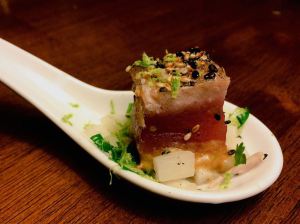Saturday, October 1, 2011

Savory, with a hint of sweetness, a sprinkle of microgreens is a nice finishing touch.
Nope, it’s not just soup and salad every night for supper. That would get boring. I love creating pretty, plated meals that star seasonal produce so here’s a serving suggestion for you. The puttanesca featured summer tomatoes, onions, and herbs. The polenta was enhanced by the addition of fresh corn. (Polenta is creamy cornmeal, and it’s better than it sounds if you’ve never had it before. In fact, it’s delicious.) Tuna is a meaty fish with big flavors, so it can stand up to the sauce. Pairing the bold flavors of puttanesca and tuna with the sweetness of creamy corn polenta made a divine dish with flavors that perfectly complimented each other. A succulent dish for the eyes and tastebuds, here’s the how-to.
First, see my recipe for homemade tomato sauce to get you started (summer version with fresh tomatoes in video here or winter version here) since puttanesca is simply a variation on the basic ingredients to which olives, anchovies, and capers are added. I wasn’t initially planning on making puttanesca, but as I was prepping my tomato sauce I decided to get some double-duty action from my chopping to make two different sauces. I’m so glad I did! Puttanesca is a rich, toothsome sauce—umami describes the flavors perfectly. Familiar with the word? Umami (think: savory) is the fifth taste humans perceive, along with sweet, salty, sour, and bitter. Wikipedia has a nice description of it.
To your tomato sauce base, add the three key ingredients: 6 or so chopped anchovies, chopped olives (1/2 to 1 cup), and a couple of tablespoons of capers. Don’t forget a handful fresh chopped parsley and/or basil, or dried, in a pinch if that’s all you have. The classic recipe uses Kalamata olives, in case you were wondering, but I’d use whatever you like or have on hand. I also always add a bit of crushed red pepper, for a little kick (optional). The exact quantities depend on how much sauce you are making, though, so consult some recipes online if you’d like more precise proportions, as you know my philosophy on recipes. Or, start off using small quantities, cook for awhile, and you can always add a bit more later. You can never go back. As it simmers (an hour or more), the flavors really come together to create a complex, multi-layered sauce. Even the color is a much deeper red compared to regular tomato sauce.
Because the olives, capers, and anchovies are fairly salty, I do not recommend adding any salt to the sauce when making it. You know that I’m always concerned with excess sodium in the diet, and this is not my regular, stand-by tomato sauce. Definitely for a special occasion. I will discuss the sodium issue in greater depth another time, but a key point is that the majority of sodium in the diet comes from prepared and processed foods. You’ll see the sodium issue is a common thread in my posts when choosing what to cook and eat. And check out my earlier post on tomatoes for more about the health benefits of eating tomatoes—for both you and the planet.
What if I don’t like olives, anchovies, and capers?
Puttanesca has some really big flavors and you may not be accustomed to using them in cooking. Perhaps you loathe them all. This dish would also be delicious with a classic, chunky tomato sauce if you’re not ready to go there. You could also leave out one of the ingredients though obviously it wouldn’t really be puttanesca by definition. (But so what?)
At some point, though, I’d encourage you to try it because the flavors are wonderful. Taste is actually quite adaptive, and if you want to expand your palate for either culinary or heath reasons (or both!), you gotta try new things. And try them often, if you want to make a real change (e.g., from white bread/pasta to whole wheat, full-fat to non-fat milk, or whatever) Not only is there research to support the “try, try again philosophy,” I’ve seen it work on friends, family, and me. I didn’t grow up eating olives, for example. But after acquiring a taste for them in my late twenties, I could not get enough. I LOVE olives now. (More here on that.)
Delicious with pasta!
A final note on puttanesca is that it can be enjoyed so many ways. This dish is a fancier serving suggestion, but it’s commonly served atop pasta. I enjoyed a plate a few nights back with whole wheat spaghetti. Such a satisfying dinner. (With a mixed green salad on the side, of course. I eat a salad with dinner just about every night, and if you don’t that’s another thing you can do to help you on your way towards better health.)
(And if you don’t care for polenta, you can serve this same exact dish on a bed of pasta, although you won’t get the same mix of flavors.)
By the way…
Oh, are you wondering about the health benefits of tuna? And its potential risks, among other issues? I can only cover so much in one post if I am to sustain your attention amidst busy schedules. We’ll get there, I promise.
—
Note: You can now read more about the health and sustainability issues of tuna here.





Y-U-U-U-U-M!
Definitely give it a try. It really was outstanding! I know you love olives as much as I do! enjoy…